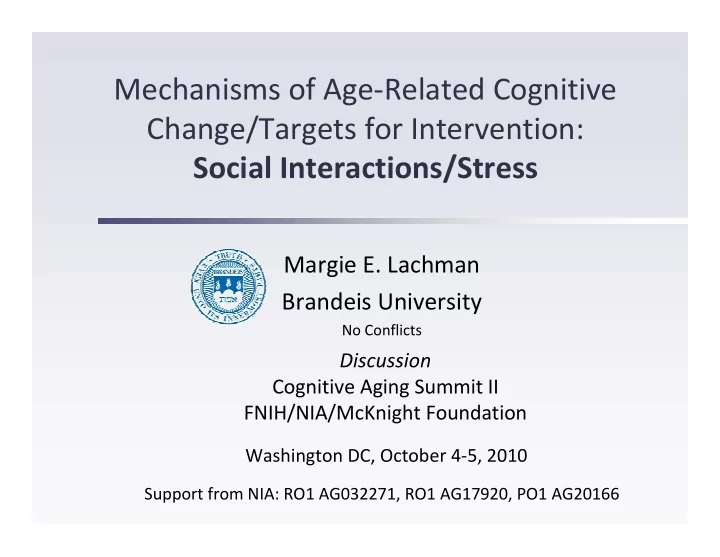

Mechanisms of Age-Related Cognitive Change/Targets for Intervention: Social Interactions/Stress Margie E. Lachman Brandeis University No Conflicts Discussion Cognitive Aging Summit II FNIH/NIA/McKnight Foundation Washington DC, October 4-5, 2010 Support from NIA: RO1 AG032271, RO1 AG17920, PO1 AG20166
Current (Lack of) Knowledge � Many reliable associations with level of cognitive functioning, but not with change � Unclear directionality of social relations, stress and cognitive functioning � “ Firm conclusions cannot be drawn about the association of any modifiable risk factor with cognitive decline or Alzheimer’s Disease ” NIH State-of-the-Science Conference, April 2010
Pieces of the Puzzle � Early Life Factors � Education � Physical Factors � Health � Psychological Factors � Personality, Self-Efficacy, Control Beliefs, Coping � Stress- Chronic, Acute, Daily, Cumulative, Reactivity � Social Factors � Social Ties, Network, Integration, Support, Conflict � Behavioral Factors � Exercise, Cognitive Activity
But… How do these psychosocial and behavioral factors get under the skull ? � What are the pathways? � If we modify these factors, does this affect cognitive aging?
Some Possible Mechanisms � Health and Disease � Hormonal Factors (e.g., Cortisol, Oxytocin) � Allostatic Load (e.g., Inflammation, Metabolic Parameters) � Neural Plasticity � Motivation, Effort, Strategy Use � Rumination, Intrusive Thinking, Distraction � Emotional Factors, Depression, Anxiety
Putting the Pieces Together Identify Mechanisms Suggest Targets for Interventions � Mediation � Multiple Mediators � Moderation- Interactions � Age, Stress, Intrusive Thoughts and Memory � Education, Cognitive Activity and Memory � Composites- Combined Effects � Protective Effects for Reasoning
Effects of Stress Condition on Task Irrelevant Thoughts Vary by Age 2 Experimental Group - Stressful Events Recall CIQ- Task Irrelevant Thoughts ** Control Group 1.6 1.2 0.8 0.4 0 Young Adults Older Adults (Rosnick & Lachman, 2009)
Frequent Cognitive Activity Moderates Education Differences in Episodic Memory Episodic Memory (z-scores) Low Cognitive Activity (-1SD) 0.3 0.2 High Cognitive Activity (+1SD) 0.1 0 -0.1 -0.2 -0.3 Low Education (-1SD) High Education (+1SD) Education (Lachman, Agrigoroaei, Murphy & Tun, 2010) Midlife in the U.S. (MIDUS) Controlling for age, sex, self-rated health, physical activity, and income
Composites- Combined Effects Factors � Social � Good quality social relations- High support, low strain = 1 � Psychological � High sense of control- High mastery, low constraints = 1 � Physical/Behavioral � Frequent vigorous physical exercise = 1 � Composite Scoring 0 to 3 (low or high on each factor )
Protective Effects of Composite for 10-year Changes in Reasoning .00 -.10 Change in Reasoning (Time 2 - Time 1) -.20 -.30 -.40 -.50 -.60 0 1 2 3 -.70 Number of Factors at Time 1 Boston Subsample of MIDUS (Agrigoroaei & Lachman, 2010) Controlling for age, sex, education, race, waist circumference, smoking, alcohol problems, functional health
Intervention Approaches � Multimodal, Multifaceted � Integrated into Everyday Life � Preventive � Target Vulnerable High Risk Groups � Experience Corps ( Fried et al .) � Healthy Lifestyle Program (Small et al.) � Computer-Mediated Support Groups (Rains & Young) Improve Existing Social Relations or Cultivate New Ones
Next Steps � Conduct Multidisciplinary Studies � Integrate Findings from Epidemiological (Survey) and Experimental (Lab) Studies � Examine Antecedents of Intraindividual Change and Variability with Longitudinal, Prospective Data � Test Mechanisms and Treatment Benefits with Interventions/RCT’s � Consider Social Policies to Facilitate Social Interactions, Reduce Stress and Promote Cognitive Health
Summary and Conclusions Explanation and Modification of Age-Related Cognitive Change � Mechanisms � All Roads Lead to Rome � There is More than One Way to � Multiple Pathways/ Skin a Cat � Moderation in All Things Mediators/Moderators � Multifaceted/Composites � The More the Merrier � The Whole Is Greater Than the Sum of Its Parts � Interventions � Kill Two Birds with One Stone � The Early Bird Catches the Worm � Multimodal � An Ounce of Prevention is Worth a � Prevention Pound of Cure
Acknowledgements Collaborators and Support � Stefan Agrigoroaei � David Almeida � Arun Karlamangla � Angela Lee � Chris Rosnick � Carol Ryff � Teresa Seeman � Ron Spiro � Robert Stawski � Patricia Tun � Lifespan Lab at Brandeis University � University of Wisconsin Institute on Aging and Survey Center � NIA: RO1 AG032271, RO1 AG17920, PO1 AG20166
Recommend
More recommend